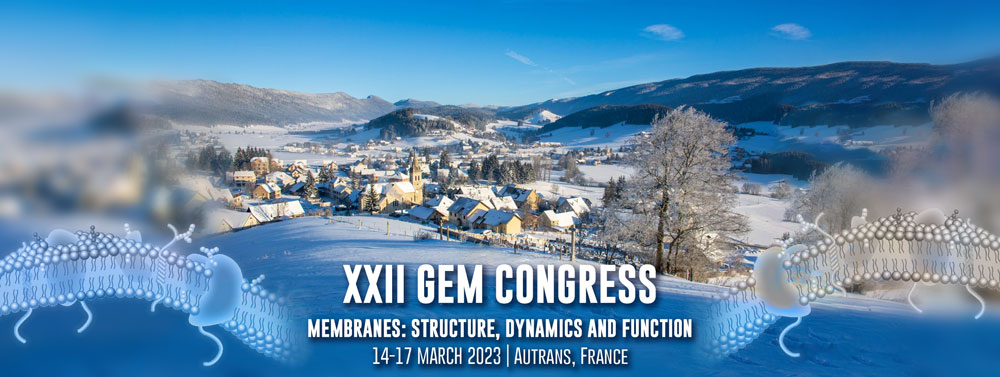Speaker
Description
The role of the lipid environment within a biomembrane is of fundamental interest to understand intercellular and cell-cell interaction. The lipid molecules define not only the cell structure and geometry but also influence the functionality and self-assembly of membrane proteins and channels.[1,2] Dynamic switching behaviour of the membrane associated proteins and channels regulates the transportation of ions and metabolites of immense cellular importance through the lipid membrane into the cell. However, the in-depth molecular mechanisms involved in the switching are poorly understood. Thus, molecular switches in biomembranes are currently under intense investigation owing to their diverse applications in biosensor engineering and drug delivery. To understand the interaction between lipid and functional molecules, we investigate photoswitchable glycoconjugates embedded in a 1,2-dipalmitoyl-phosphatidylcholine (DPPC) model systems in the form of Langmuir films and vesicles. Here, the structure of photoswitchable glycoconjugates change reversibly between their trans- and cis-conformation by illumination with visible and UV light[3] inducing a reversible change in the molecular arrangement within the surrounding membrane[4]. The resulting structural changes, their evolution and time scales are characterised with multiple measurement techniques including absorption spectroscopy, surface pressure-area isotherm, X-ray reflectivity, grazing incident X-ray diffraction and also X-ray and neutron small angle scattering. Studies performed on mixed monolayers with varying glycoconjugates identify an additional phase transition, which unexpectedly represents a crossover point. The surface pressure and monolayer thickness change in opposite directions above and below the phase transition indicate that the photoswitchable glycoconjugates change orientation within the monolayer. In vesicles the switching induces a reversible transition between lamellar and cubic phase at room temperature. Therefore, photoswitchable glycoconjugates can act as a bidirectional switch in DPPC monolayers and vesicles.
In addition, as this work is part of a pilot project within the DAPHNE4NFDI consortium [5], the best practice for scientific data handling to ensure that our data is findable, accessible, interoperable and re-usable (FAIR), will be discussed.
[1] Laganowsky, A., Reading, E., Allison, T. M., Ulmschneider, M. B., Degiacomi, M. T., Baldwin, A. J., Robinson C. V. (2014). Nature 510, 172.
[2]. Phillips, R., Ursell, T., Wiggins, P., Sens, P. (2009). Nature 459, 379.
[3] Reise, F., Warias, J. E., Chatterjee, K., Krekiehn, N. R., Magnussen, O., Murphy, B. M., Lindhorst, T. K. (2018). Chemistry – A European Journal 24, 17497-17505.
[4] Warias, J. E., Reise, F., Hövelmann, S. C., Giri, R. P., Röhrl, M., Kuhn, J., Jacobsen, M., Chatterjee, Arnold, T., Shen, C., Festersen, S., Sartori, A., Jordt, P., Magnussen, O., Lindhorst, T. K., Murphy, B. M. submitted.
[5] DAPHNE4NFDI is a National Research Data Infrastructure consortium funded by the German German Research Foundation (DFG). https://www.daphne4nfdi.de/
| Session | Interaction lipids/polymers/membrane proteins |
|---|

